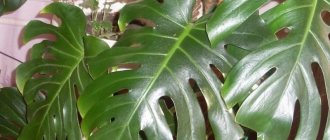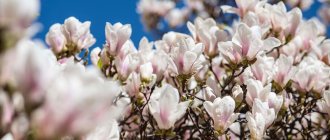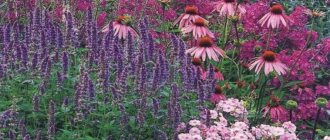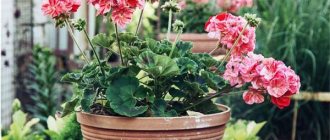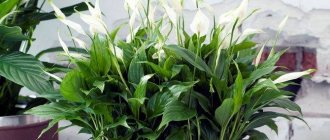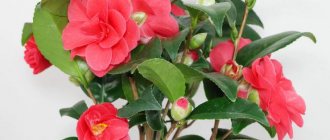Types and varieties of aglaonema
Several species of aglaonema are grown in culture, some have cultivars.
Aglaonema commutatum. This species is most often grown at home. Her homeland is the Philippines. In nature it can reach a height of 1.5 m, but at home it is much lower - usually within 30 - 50 cm. The leaves of the natural form are dark green with a silvery pattern. They are oblong in shape, on long petioles (up to 25 - 30 cm).
This species has several interesting varieties that differ in leaf color.
- Silver Queen - silver leaves with green spots;
- Silver King - similar to the previous species, the leaves are also silver with green spots, but the spots are larger and located along the veins;
- Maria Christina - leaves are silvery-white, with a green edging along the edge and a few green spots along the veins;
- Maria Anna is an almost exact copy of Maria Christina, with the same leaf color, but they are smaller in size;
- Treubii - leaves are green with ash-gray spots along the central vein.
Photo: Tiia Pakk, pexels.com
Aglaonema modestum. This species naturally lives in tropical forests and on the mountain slopes of China, in the southeastern part of Bangladesh, in the northern regions of Thailand and Laos. Plants are 40 - 70 cm high, leaves 15 - 20 cm long, green, without a pattern - hence the name of the species - modest.
Aglaonema ribbed (Aglaonema costatum). This is the shortest among the aglaonemas, its height usually does not exceed 30 cm. It is found naturally in the tropical forests of Malaysia. Its leaves are about 20 cm long and 10 cm wide, dark green, with a white vein in the center and numerous white spots and streaks over the entire surface.
Aglaonema shiny (Aglaonema nitidum). In nature, this species is found in the tropical forests of Malaysia, Thailand, Burma, on the islands of Sumatra and Borneo. The plant is quite large, about 1 m high, and the leaves reach a length of 45 cm. They are green, glossy, without a pattern. But unlike other species, this one produces white fruits after flowering (the others have red ones), which gives this aglaonema a special charm.
Aglaonema pictum. Perhaps one of the most beautiful species, this Aglaonema has stunning velvety green leaves with wavy edges and lots of fancy flecks of light cream, gray and silver. That is why botanists gave the species the name – painted. It is native to the tropical rainforests of Borneo and Sumatra. Reaches a height of 60 cm.
Aglaonema has many varieties that were developed by crossing different species.
- Crete (Crete) - this aglaonema belongs to the so-called group of “red varieties”, at a young age its leaves are completely red, but with age green shades appear in them - from grass to olive, but the central vein remains scarlet;
- Pink Moon - with dark green leaves, a pink central vein and a few pale pink spots;
- Green Papaya - with dark green leaves, pale pink petioles and central vein, numerous yellow streaks;
- Chocolate (Chocolate) - with spectacular striped leaves, which alternate shades of dark green, silver and pink;
- Prestige - with beautiful spotted leaves in shades of green, pink, red and cream;
- Pink Dalmatian - with stunning jade-hued leaves with lots of splashes of hot pink;
- Red Valentine - with beautiful leaves of red and pink, along the edges of which a green edging of spots is scattered;
- Sparkling Sarah - with green leaves and numerous spots of pink and cream shades;
- Red Anjamani - with bright red leaves and green edges;
- Siam Aurora - with dark green leaves and a thin pink edge.
- Bidadari - with creamy pink leaves and a few green spots;
- Super White - with pure white leaves with a green central vein and green spots;
- Harlequin - with green leaves, along which are scattered numerous touches of cream and pink.
Aglaonema (Green Papaya). Photo: pixabay.com
Aglaonema (Red Valentine). Photo: pixabay.com
Agrostemma, or cockle (Agrostemma)
This sophisticated annual plant is characterized by its short growth (up to 50 cm). On thin stems there are narrow pubescent leaves and rather large pink-crimson flowers with five petals. These delicate “stars” bloom at the beginning of summer and decorate the garden until September. At the same time, they open in the morning and close in the afternoon.
Plant care is minimal. It is enough to sow the seeds in open ground and then thin out the dense growth. The dense greenery of the agrostemma perfectly blocks weeds, which eliminates the need for frequent weeding.
Caring for aglaonema at home
Aglaonema is a rather unpretentious plant, but there are several features of agricultural technology that are worth considering.
Priming
For aglaonema, store-bought soil for decorative foliage plants is suitable, but it is useful to add vermiculite to it so that moisture is retained in the soil longer.
Lighting
Since aglaonemas grow in tropical rain forests, they easily tolerate a lack of light, so they can be grown even in the back of a room. But where they definitely don’t belong is on a south-facing windowsill, because the leaves “burn” under the direct rays of the sun.
Humidity
All types of aglaonema love high humidity, both soil and air. They need to be watered frequently, or even better, place the pot in a tray with damp pebbles or sand. And spray as often as possible.
In winter, watering should be reduced - once a week will be enough.
Photo: A. Jagel, globallookpress.com
Fertilizers
When planting a plant in the soil, you do not need to add any fertilizers - for the first time, the nutrients contained in the soil will be enough.
Feeding
During the period of active growth (usually from March to October), aglaonemas need to be fed once every 2 weeks with liquid complex fertilizer for indoor plants. In winter, fertilizing is not needed.
Trimming
In tall species of aglaonema, over time the stems become bare, the leaves remain only at the top. In this case, the plant can be trimmed - the top can be rooted, and new shoots will grow from the buds located on the trimmed stem, and the bush will be dense.
Armeria
This perennial has about 90 species. The color of the flowers can be white, pink, crimson, lilac, red. The height of the plants, depending on the species and variety, ranges from 15 to 60 cm. On the straight stem there are numerous linear-lanceolate leaves collected in a basal rosette. Small flowers, collected in capitate inflorescences, decorate the plant in May-August.
Armeria is usually grown from seeds: with the seedless method, the seeds are sown before winter, and seedlings are sown in late February - early March. In addition, Armeria reproduces well by self-sowing.
Aglaonema diseases
Problems with aglaonema can occur with improper care.
The roots are rotting. This happens when a plant is overwatered, especially if it stands on a cold windowsill in winter.
In this case, it needs to be replanted in new soil, a good layer of drainage should be placed on the bottom, and, of course, all rotten roots should be cut off.
The tips of the leaves dry out. This happens if the air in the room is too dry.
Frequent spraying or bowls of water that need to be placed on the windowsill will help solve the problem.
Reproduction Philodendron Pink Princess
Like most philodendrons, pink princess can be easily propagated from stem cuttings. This will not only help you create a new plant that you can share with a friend. This propagation will result in a bushier plant and may promote diversity. Especially if the leaves on your plant have started to fall off.
How to propagate philodendron from cuttings in just a few steps:
- First, choose where you will cut the plant stem. Try to make the cut so that the cutting has 2-3 leaves and 2-3 open nodes at the bottom.
- Using sharp, sterilized scissors or pruning shears, cut the stem and remove the stem.
- Remove the lower leaves, leaving only 2-3 leaves at the top.
- Set the cutting aside for 12 to 24 hours to allow the cut edge to harden.
- Once the edge has hardened, place the cutting in water. Place it in a place that receives bright, indirect light. Make sure exposed parts are immersed in water and remain submerged at all times.
- Within 2-3 weeks you should start to notice new roots growing from the cutting.
- When the roots grow 2-3 centimeters in length, you can transfer the cuttings to the soil. Use a well-draining mix and water thoroughly.
Reproduction Philodendron Pink Princess
Popular questions and answers
We talked about the features of growing aglaonema with agronomist-breeder Svetlana Mikhailova.
How to choose aglaonema?
When choosing a plant, pay attention to its appearance - the leaves should be healthy, richly colored, and without signs of damage. If possible, remove the aglaonema from the pot along with the earthen lump and inspect the roots - it is important that they show no signs of rotting.
Does Aglaonema bloom?
Yes, it blooms, but not often at home. Aglaonema flowers look like miniature calla lilies - with a yellow spadix and a white or light green spathe.
Why does aglaonema turn yellow?
Aglaonema leaves may turn yellow due to lack or, conversely, too much watering. The second reason is pests.
Why do spots appear on the leaves of Aglaonema?
Spots may appear due to dry air. Or if the plant was sprayed, after which it was exposed to direct rays, this could be sunburn.
Why do Aglaonema leaves curl?
There are also 2 reasons here: - they didn’t water it on time; — the plant was attacked by pests.
Why do the leaves of Aglaonema dry out?
Most likely, the plant does not have enough moisture - it is either rarely watered or not sprayed enough. Leaves can also dry out if they are severely damaged by pests, such as spider mites.
Caladium
Caladium is a beautiful indoor plant with decorative leaves. Due to the red-pink color of the leaves, experts call it “angel wings” and “elephant ears.” The flowers, like those of other plants, are inconspicuous. In order for a bush with leaves to be pleasing to the eye, it is necessary to maintain a temperature in the room of +22…+27°C.
A flower needs intense lighting: the brighter the leaves, the more light it needs. Lack of moisture leads to drying of leaves and reduced growth rate.
Whatever plant you choose from the five options, any one will delight you with its pink leaves and stand out among other nondescript indoor flowers. If you take proper care of such a plant, its bright and unusual color will make the room more beautiful and comfortable.
Carnation (Dianthus)
Pink and crimson flowers are found in Alpine, Amur, bearded, capitate, pinnate, Chinese, grass, Shabot and other types of carnations. This popular plant has many faces, so everyone can choose a flower to their liking.
- What types of carnations are there - photos, descriptions of types, popular varieties
Types and varieties of garden carnations with detailed descriptions and photos.
As a rule, carnations are undemanding to soil, resistant to diseases and pests, overwinter well without shelter, are unpretentious in care, but bloom better in well-lit areas and with regular watering.
Gladiolus, or swordweed (Gladiolus)
Even beginners are familiar with these popular colors. Thanks to their tall and dense flower stalks, gladioli are ideal for cutting. The colors of the flowers vary, including many shades of pink.
Gladioli love bright, draft-free areas with well-drained soil with an acidity level of pH 6.5-6.8. For the winter, plant bulbs are dug up and stored until spring in a basement or cellar at a temperature no higher than 5-10°C and a humidity of approximately 60-70%.
- When to dig up gladioli bulbs in the fall and where to store them until spring
Everything about harvesting and storing gladioli depending on the variety, region and even color.
- Planting and growing gladioli - instructions in pictures
Growing gladioli from purchasing the bulbs to sending them for winter storage.
Dahlia (Dahlia)
The dahlia is distinguished by a wide palette of colors and a variety of flower shapes. The plant blooms from July to autumn. For good growth and lush flowering, you just need to choose the right planting site, provide suitable soil, timely watering and fertilizing. You should buy tubers no earlier than mid-spring; they should be fleshy and strong. And patient gardeners can try growing charming dahlias from seeds.
- How to grow dahlias from seeds and tubers - experts share secrets
Growing dahlias will not give you any trouble if you follow these rules.
Phlox
Phloxes delight in their variety of shapes, sizes and shades. Among them there are bush and ground cover species that bloom in spring and summer. Phlox with pink flowers can be found in almost every type of this plant.
- Popular types and varieties of perennial phlox
5 types and 21 varieties of phlox for every taste.
This is the perfect flower for any flower garden. Low awl-shaped phloxes are best suited for rockeries and borders, and paniculate phloxes are best suited for mixborders and solitary plantings.
Rose
This queen of the flower garden needs no introduction. Roses are varied in the shape and color of flowers, the structure of the bush, etc. But it is pink roses that are a classic. And in each species there are varieties with the same color of petals.
- What types of roses are there - an overview of groups, types and varieties
Classification of roses and description of their main groups with a list of popular varieties.
All roses need good lighting, nutritious and loose soil, timely watering, fertilizing with complex mineral fertilizer and proper pruning. Most varietal roses in the middle zone overwinter only with shelter, but there are also winter-hardy specimens (for example, Canadian roses).
Stock rose (Alcea rosea)
This tall plant (up to 2 m) from the Malvaceae family is often popularly called mallow, but in reality, the hollyhock and mallow are different species, although closely related. The hollyhock rose has a corolla consisting of 5 fused petals. In the center of the flower there are many stamens fused into a tube.
Classic varieties of stock roses are distinguished by simple pink flowers, while modern decorative varieties have already become a favorite among gardeners for their large double flowers in bright colors: white, pink, red, burgundy, crimson, beige, yellow, purple-black. Flowering lasts from early summer until late autumn, until a cold gusty wind breaks the stems of the plant.
